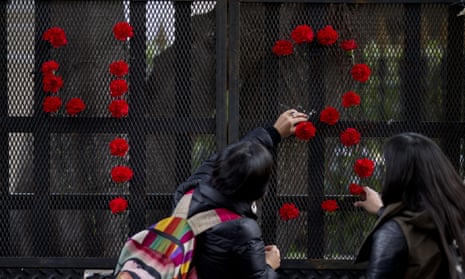People vanishing into thin air, mass graves filled with bones so small DNA tests are impossible to conduct and dismembered bodies dumped in abandoned trucks are now so common in Mexico that they hardly make front-page news. But the Ayotzinapa tragedy – as the disappearance of 43 students in the Mexican city of Iguala a year ago is now known, in reference to the school where the students came from – is different.
It’s been a year since they went missing, revealing a country riddled with violence and horror, and pressure over the handling of the investigations is mounting. The only way forward for the Mexican authorities is to show that they are serious about finding out what happened to the 43 on 26 September 2014 and ensure it never happens again.
The tragedy has revealed a human rights crisis of epic proportions, with nearly 30,000 men, women and children disappeared or missing in the last few years alone. But more than that, it has peeled the mask off the Mexican government’s negligence.
For years, President Enrique Peña Nieto’s administration has not done enough to respond to countless allegations of torture, extrajudicial executions and disappearances. They blame organized crime for such problems, simplifying a complex network of criminality and corruption.
According to the official narrative, those tortured, killed or disappeared are the victims of unscrupulous and extremely powerful criminal gangs or are somehow to be blamed for the abuses they suffer. Investigations into any kind of human rights abuses are routinely so poor that examinations of crime scenes are negligent or non-existent.
When pressure mounts, authorities round up a number of suspects who quickly take responsibility – and later report having been tortured to confess to the crimes. In 2013, Mexico’s National Human Rights Commission said it had received 1,505 complaints of torture and other forms of ill-treatment, 600% more than in 2003.
Meanwhile, there is a lack of prosecution of those accused of torture. According to the Federal Judicial Council, federal courts dealt with 123 prosecutions for torture between 2005 and 2013, and just seven resulted in convictions under the federal law.
The Mexican justice system is so flawed no one expects much from it anymore. Trials over human rights abuses are extremely rare and relatives of the disappeared are left waiting in desperation or forced to look for their loved ones themselves.
In this backdrop, the disappearance of the 43 Ayotzinapa students should not be a surprise. But it has struck a chord and cornered the Peña Nieto administration into taking what can only be described as desperate steps to show it is actually taking action. But these steps don’t appear to be actually accomplishing anything.
First came the “historical truth” when the country’s attorney general said, on 27 January, that the police had arrested the students before handing them over to a renowned local drug gang. In turn, Guerreros Unidos, as it is known, were said to have killed them, burned their bodies in a local dumpster, before packing the remains in large bags and throwing them into a nearby river. On 6 September 2015, a group of independent experts appointed by the Inter-American Commission on Human Rights issued a 500-page report refuting the theory as scientifically impossible.
But the Mexican authorities didn’t take the criticism seriously. As the first year anniversary of the disappearances approached, with 110 arrests made, the authorities called a press conference and announced that they had found a bone matching the DNA of 20-year-old Jhosivani Guerrero de la Cruz, one of the disappeared students. Experts from the Argentinean forensic anthropology team found: “the genetic coincidence found during the DNA tests is not high enough for it to be considered a positive identification of Jhosivani Guerrero de la Cruz.”
It is still not too late for officials to hold their hands up, admit the serious mistakes made to date and redirect investigations into the disappearances. Failing to take any action will only sink the Peña Nieto administration deeper into suspicion.
The president and administration were once hailed as the country’s hope, but now they are desperately trying to hold on to any shred of credibility. The first crucial step to rebuilding this trust lies in answering a simple question – where are the 43 Ayotzinapa students?
